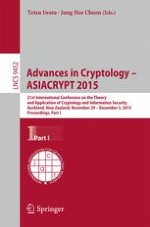2015 | OriginalPaper | Buchkapitel
Compactly Hiding Linear Spans
Tightly Secure Constant-Size Simulation-Sound QA-NIZK Proofs and Applications
verfasst von : Benoît Libert, Thomas Peters, Marc Joye, Moti Yung
Erschienen in: Advances in Cryptology -- ASIACRYPT 2015
Verlag: Springer Berlin Heidelberg
Aktivieren Sie unsere intelligente Suche, um passende Fachinhalte oder Patente zu finden.
Wählen Sie Textabschnitte aus um mit Künstlicher Intelligenz passenden Patente zu finden. powered by
Markieren Sie Textabschnitte, um KI-gestützt weitere passende Inhalte zu finden. powered by
